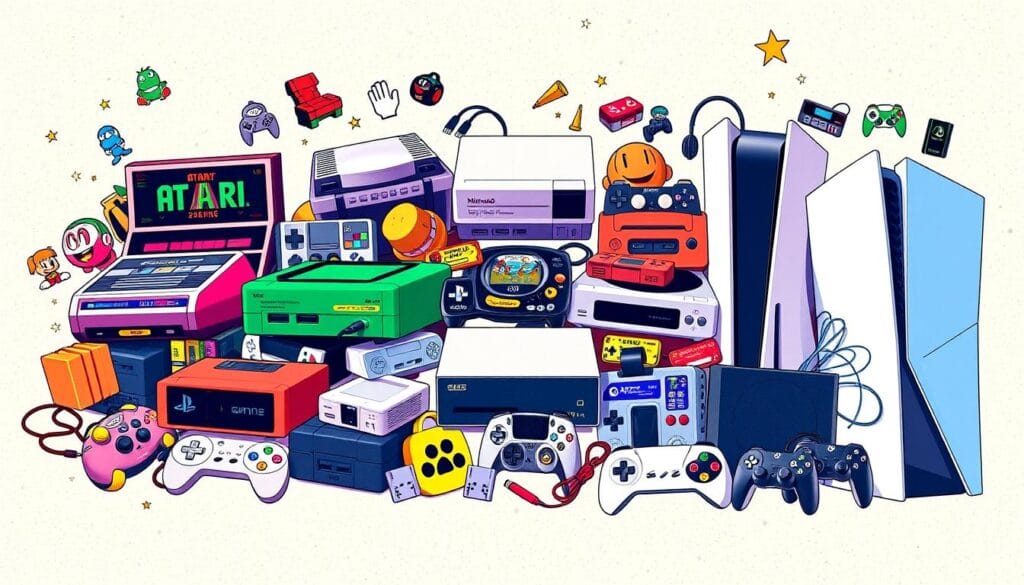The Evolution of Gaming Consoles: From Atari to PlayStation 5
I remember spending hours in front of our Atari 2600. It was mesmerizing, with its pixelated graphics and the sound of the joystick. These moments started a revolution in gaming technology. It changed how we enjoy entertainment.
From the Magnavox Odyssey to the PlayStation 5, consoles have evolved fast. They’ve kept up with technology, shaping our culture and changing how we tell stories.

Key Takeaways
- The gaming console industry has undergone a remarkable transformation over the past five decades.
- Consoles have played a pivotal role in defining popular culture and revolutionizing various aspects of entertainment, technology, and communication.
- The journey from the Magnavox Odyssey to the PlayStation 5 has been marked by significant hardware advancements, genre-defining games, and the emergence of online gaming.
- The gaming industry has experienced both periods of growth and decline, with the Nintendo Entertainment System (NES) and Sony’s PlayStation being key drivers of its resurgence.
- The future of console gaming promises even more immersive experiences, with the ongoing development of virtual reality, haptic feedback, and cloud-based streaming technologies.
The Birth of Home Gaming: First-Generation Consoles
In the early 1970s, gaming at home made a big leap forward. The Magnavox Odyssey became the world’s first home video game console. Ralph Baer, a pioneer, created it. It had simple graphics and no sound but marked the start of gaming history.
Then, Atari’s Pong system hit homes in America, becoming a big hit. Companies like Coleco and Magnavox led the home video game market. They tried out different console designs and games.
The Magnavox Odyssey Legacy
The Magnavox Odyssey, launched in 1972, was the first home gaming console. It had 12 games, like table tennis and handball, and worked with any TV. Its simple graphics didn’t stop it from setting the stage for home gaming’s future.
Atari’s Revolutionary Pong System
In 1972, Atari brought out Pong, a digital table tennis game. It was a huge hit in arcades. The home version of Pong became a must-have, making home gaming consoles more popular.
Early Console Market Competition
The early console market was very competitive. Companies like Coleco, Magnavox, and Atari fought for customers. Legal fights, like the one between Magnavox and Atari, showed the industry’s growing pains. This time set the stage for the iconic consoles and milestones that shaped the industry.

The Golden Age of 8-Bit Gaming
The late 1970s and 1980s were the “Golden Age” of retro gaming. This time saw the rise of more powerful gaming consoles and iconic franchises. The Nintendo Entertainment System (NES), launched in 1985, was key in saving the industry from a crash in 1983.
It introduced strict quality control and brought us legendary games like “Super Mario Bros.,” “The Legend of Zelda,” and “Metroid.” The NES became a market leader, setting new standards for game design and restoring faith in gaming technology.
Released in 1977, the Atari 2600 revolutionized entertainment by bringing video games into households as a mainstream activity. It featured hits like “Space Invaders” and “Pac-Man.” The Magnavox Odyssey, released in 1972, was the first home video game console, starting the shift from arcades to homes.
The console wars era began with the Sega Genesis in 1988. It competed with Nintendo’s NES with its 16-bit technology and targeted older audiences. Its hits, like “Sonic the Hedgehog,” helped it gain a big market share.
“Iconic games such as “Pac-Man,” “Donkey Kong,” and “Galaga” captivated players around the globe, laying the groundwork for future technological advancements in gaming.”
The 1980s and early 1990s were the golden era of arcade games. Classics like “Pac-Man,” “Donkey Kong,” and “Galaga” drew players worldwide. This era set the stage for future gaming technology advancements.

The video game industry has grown, with the rise of triple-A titles and mobile gaming. It has also explored new technologies like virtual reality and blockchain. Yet, the Golden Age of 8-Bit Gaming remains a beloved part of gaming history, inspiring and delighting gamers today.
Evolution of Gaming Consoles: The Nintendo vs Sega Era
In the late 1980s and early 1990s, Nintendo and Sega were at the top of the console gaming world. They were in a fierce battle for gamers’ attention and loyalty. This time was known as the “console wars.”
Nintendo Entertainment System’s Market Dominance
Nintendo was already a big name with its Nintendo Entertainment System (NES). It had hit games like Super Mario Bros. and The Legend of Zelda. The NES’s success made Nintendo the leader, and they wanted to stay on top.
Sega’s Strategic Response
Sega wanted to take Nintendo’s place. In 1988, they introduced the Sega Genesis. It had better graphics and sound than the NES. Sega used Sonic the Hedgehog to show the Genesis was cool, unlike Nintendo’s games.
The 16-bit Console Wars
The battle between the NES and Genesis was intense. Both sides released amazing games. This competition led to some of the best games ever, like Super Mario World and The Legend of Zelda: A Link to the Past.
The console wars have shaped gaming culture. They paved the way for innovations like online multiplayer gaming and immersive virtual reality experiences. Even today, Sony’s PlayStation and Microsoft’s Xbox compete, pushing the industry forward.
“The competitive strategy by Sega in marketing the Genesis influenced the development of the modern video game console war.”
Console wars have made gaming better, with more choices and innovation. But, they also created a toxic gaming culture. Fanboyism and exclusivity have hurt the community.
The Revolution of 3D Graphics and CD-ROM Technology
The mid-1990s were a big change for gaming consoles. The industry saw a leap forward in 3D graphics and CD-ROM technology. This time brought consoles that changed game design, graphics, and storytelling.
Sony’s PlayStation, released in 1994, was a leader in this change. It used CD-ROMs, not cartridges, for bigger and more detailed games. This led to hits like Final Fantasy VII and Metal Gear Solid. These games amazed players with their movie-like stories and amazing graphics.
In 1996, Nintendo came out with the Nintendo 64. It had an analog stick and cool features like four-player games. Titles like Super Mario 64 and The Legend of Zelda: Ocarina of Time showed off the console’s power. They mixed smooth 3D worlds with engaging stories and fun gameplay.
These steps forward in gaming technology and hardware changed the gaming world. They set the stage for the iconic consoles that shaped the industry for years.
“The PlayStation’s use of CD-ROMs allowed for larger, more complex games that pushed the boundaries of what was possible in the gaming world.”
Sony’s PlayStation Dynasty: Changing the Game
The PlayStation brand has been a big name in gaming since the late 1990s. Sony’s first PlayStation console brought 3D graphics and CD-ROM tech to the table. This was a big step forward in gaming. The PlayStation 2, released in 2000, made Sony a top player in console gaming.
PlayStation’s Market Disruption
The PlayStation 2 became the best-selling console ever, with over 155 million units sold. It combined DVD playback with a huge game library. This made it essential for both gamers and casual users, changing console gaming forever.
The PS2 Era and DVD Integration
The PlayStation 3, launched in 2007, pushed tech boundaries even further. It introduced Blu-ray discs and the PlayStation Network. This allowed for online gaming and digital content sharing.The PS3 firmly established Sony as a dominant force in the ever-changing world of gaming consoles.
PlayStation’s Online Gaming Evolution
The PlayStation 4, released in 2013, improved online gaming with PlayStation Plus. This service gave users free games, multiplayer, and special deals. It made PlayStation a key player in gaming milestones and online gaming.
The PlayStation 5, out in 2020, brought even more tech advancements. It features ray tracing, 120 FPS, and 4K resolutions. Sony’s commitment to innovation has made PlayStation a gaming dynasty that has transformed the industry.
Microsoft Enters the Arena: The Xbox Legacy
In 2001, Microsoft made its debut in the console gaming market with the launch of the Xbox. It featured a cutting-edge CPU paired with a uniquely designed GPU. It also had a built-in hard drive, making it stand out.
The Xbox 360 came out in 2005 and made Microsoft a big player in the console wars. It had many models, each with different storage. It also had new features like HDMI and wireless controllers.
The Xbox One was released in 2013. It had a strong CPU and a special GPU. It was great for watching movies and playing games, with models like the Xbox One S and X.
The Xbox Series X came out in 2020. It has a fast CPU and a powerful GPU. It can play games in 4K at 120fps. The Series S is more affordable and plays games at 1440p.
The Xbox brand has brought many new ideas to gaming. It introduced achievements and party chat. Microsoft’s consoles have become a big part of online gaming, competing with Sony’s PlayStation.
The Innovation of Gaming Controllers
The journey of gaming controllers has been exciting. It shows how technology has changed the video game world. From simple joysticks to today’s motion-sensing controllers, they’ve become key to gaming.
From Simple Joysticks to Motion Controls
In the early days, joysticks were all we had. They let us move characters and explore simple game worlds. But then, Nintendo changed everything with the Wii in 2006. The Wii Remote used sensors to let players control games with their movements.
Modern Controller Features and Haptic Feedback
Today’s controllers are packed with features. The DualSense controller for the PlayStation 5, for example, has advanced haptic feedback and adaptive triggers. These features make games feel more real and responsive. They also have ergonomic designs and easy connectivity.
The Future of Gaming Input Devices
The future of gaming looks bright. Gaming technology is getting even better. Pioneers are working on virtual reality, motion tracking, and brain-computer interfaces. These could change how we play games, making them even more immersive.
| Milestone | Impact |
|---|---|
| Magnavox Odyssey and Atari 2600 | Established business models, consumer expectations, and technology standards |
| Nintendo Wii | Introduced motion controls, revolutionizing player interaction |
| PlayStation 5 DualSense | Incorporated advanced haptic feedback and adaptive triggers |
| Virtual Reality Integration | Driven the need for more powerful hardware to deliver immersive experiences |
“The future of gaming input may include more advanced motion tracking, virtual reality integration, and even brain-computer interfaces.”
Next-Gen Gaming: PS5 and Xbox Series X
The gaming world has changed a lot with the PS5 and Xbox Series X. These consoles bring new tech, better graphics, and a smoother gaming experience.
Released in November 2020, the PS5 and Xbox Series X incorporate cutting-edge AMD processors, setting new benchmarks for gaming performance. They also have ray tracing for real-looking graphics and fast SSDs for quick game starts.
The PS5’s DualSense controller is special. It has haptic feedback and adaptive triggers. This lets players feel game actions, like bowstring tension or gun recoil.
The Xbox Series X has a cool feature called Quick Resume. It lets you switch games without closing them. This is great for playing many games at once.
Both consoles support 4K gaming and high frame rates. They also work with old games, thanks to backward compatibility. The PS5’s Tempest 3D AudioTech makes sounds feel more real.
The PS5 and Xbox Series X are big steps forward in gaming technology, hardware advancements, and console generations. They offer an amazing gaming experience for all players.
“The introduction of the PS5 and Xbox Series X has redefined the gaming experience, delivering extraordinary performance and an unprecedented level of immersion.”
The Impact of Online Gaming and the Evolution of Digital Game Distribution
The gaming world has changed a lot, thanks to online gaming and digital distribution. Xbox Live and PlayStation Network have made playing with others and buying games online easy. This has changed how we play and buy games.
Services like Google Stadia and Xbox Cloud Gaming are reshaping the way we play, offering seamless accessibility and driving cutting-edge technological progress. They let you play games without needing a console. This could make gaming more accessible to more people.
Digital distribution has also changed the game. It makes buying, updating, and playing games easier. But, it raises questions about the value of digital games and who owns them.
Online gaming has also brought us together. It has created big communities and competitive scenes. Platforms like Twitch have changed how we share and watch gaming content.
| Advantages of Digital Distribution | Disadvantages of Digital Distribution |
|---|---|
| Eliminates manufacturing, packaging, and shipping costs Provides valuable data on player behavior for targeted marketing Offers flexible pricing based on demand and market conditions Allows games to be accessed from any device linked to the player’s account | Consumers do not have the ability to trade, sell, or lend physical copies Requires a stable internet connection for playability Strict refund policies can lead to customer disputes Ownership of digital games is often ambiguous compared to physical copies |
The gaming world is always changing, thanks to online gaming and digital distribution. These changes have made gaming more connected and exciting. They’re shaping the future of console gaming in big ways.
Conclusion: The Future of Console Gaming
The gaming world is always changing, and console gaming is getting better. Sony, Microsoft, and Nintendo are leading the way. They’re making gaming technology more powerful and exciting.
Online multiplayer and mobile gaming have changed console gaming a lot. But the industry has grown to include digital services like Xbox Game Pass and PlayStation Plus. This makes gaming easier to get into and more fun for players.
There’s also a big push to add virtual reality (VR) and augmented reality (AR) to consoles. This could make games feel more real and change how we play. As VR and AR get better, consoles might become even more special or focus on streaming games.
FAQ
What were the first home gaming consoles?
The Magnavox Odyssey, released in 1972, was the first home gaming console. It had simple black-and-white graphics and no sound. Atari’s Pong, introduced in 1975, became a hit and made gaming popular at home.
What was the “Golden Age” of gaming consoles?
The late 1970s and 1980s were the “Golden Age” of gaming consoles. This era saw the release of the Nintendo Entertainment System (NES) in 1985. It brought legendary franchises like Super Mario Bros. and The Legend of Zelda.
How did the console wars between Nintendo and Sega shape the industry?
The late 1980s and early 1990s saw a fierce battle between Nintendo and Sega. The Sega Genesis, released in 1988, offered 16-bit graphics. This rivalry led to some of the best games of the era, like Super Mario World and The Legend of Zelda: A Link to the Past.
How did the introduction of 3D graphics and CD-ROM technology impact gaming consoles?
The mid-1990s saw a big change with 3D graphics and CD-ROM technology. Sony’s PlayStation, released in 1994, used CDs for larger games. The Nintendo 64, released in 1996, also pushed game design and graphics with titles like Super Mario 64 and The Legend of Zelda: Ocarina of Time.
How has Sony’s PlayStation brand dominated the gaming industry?
Sony’s PlayStation brand has led the gaming industry since the late 1990s. The original PlayStation introduced 3D graphics and CD-ROM technology. The PlayStation 2, released in 2000, became the best-selling console, featuring DVD playback and a vast game library.
How has Microsoft’s Xbox brand impacted the gaming industry?
Microsoft entered the console market in 2001 with the Xbox. It had a built-in hard drive and Xbox Live online service. The Xbox 360, released in 2005, popularized HD gaming and online features. The Xbox One, launched in 2013, focused on multimedia and digital distribution.
How have gaming controllers evolved over time?
Gaming controllers have changed a lot since the early days. Nintendo introduced motion controls with the Wii in 2006. Modern controllers, like the DualSense for the PlayStation 5, have advanced haptic feedback and ergonomic designs. The future may include more advanced motion tracking and virtual reality integration.
What are the key features of the latest generation of gaming consoles?
The latest consoles, like the PlayStation 5 and Xbox Series X, launched in 2020. They have powerful AMD processors, ray tracing, and SSDs for fast loading. The PS5’s DualSense controller has haptic feedback and adaptive triggers. Both consoles support 4K gaming and high frame rates, marking a big leap in technology.
How have online gaming and digital distribution transformed the gaming landscape?
Online gaming and digital distribution have changed the gaming world. Services like Xbox Live and PlayStation Network made multiplayer gaming and digital purchases common. Streaming services like Google Stadia and Xbox Cloud Gaming are exploring new ways to deliver games. Digital distribution has changed how games are sold and updated, while online gaming has created new communities and competitive scenes.





